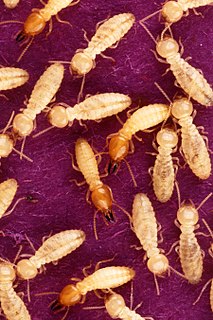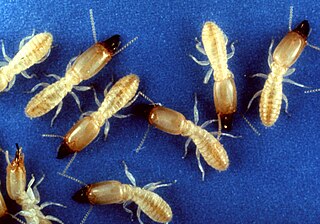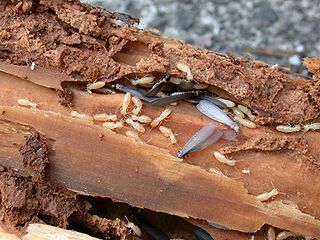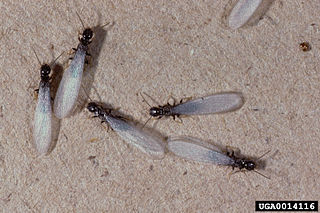
Termites are eusocial insects that are classified at the taxonomic rank of infraorder Isoptera, or as epifamily Termitoidae within the order Blattodea. Termites were once classified in a separate order from cockroaches, but recent phylogenetic studies indicate that they are related to cockroaches, as they are the sister group to wood eating cockroaches of the genus Cryptocercus. Previous estimates suggested the divergence took place during the Jurassic or Triassic. More recent estimates suggest they have an origin during the Late Jurassic, with the first fossil records in the Early Cretaceous. About 3,106 species are currently described, with a few hundred more left to be described. Although these insects are often called "white ants", they are not ants, and are not closely related to ants.
Heneicosane is a straight chain saturated hydrocarbon with formula C21H44

Reticulitermes flavipes, the eastern subterranean termite is the most common termite found in North America. These termites are the most economically important wood destroying insects in the United States and are classified as pests. They feed on cellulose material such as the structural wood in buildings, wooden fixtures, paper, books, and cotton. A mature colony can range from 20,000 workers to as high as 5 million workers and the primary queen of the colony lays 5,000 to 10,000 eggs per day to add to this total.
Bacillus oleronius is a Gram-negative bacterium belonging to the genus Bacillus. However, Bacillus oleronius has Gram-positive cell wall components shared among all bacillus species. It was first described in 1995 and was found in the hindgut of the termite Reticulitermes flavipes. It is also found in the human skin parasitic mite Demodex folliculorum, and may be related to the development of a type of acne rosacea.

Tandem running is a social learning phenomenon seen mostly in ants, by which one ant leads another native ant from the nest to the food source it has found. Tandem running is also used to find and choose better, new nest sites to which the colony can emigrate. The follower ant maintains contact with the lead ant by frequently touching the leader’s legs and abdomen with its antennae. As predators, scavengers, and herbivores, ants have a variety of food sources, for which they may journey as far as 200 meters from their nest, spraying a scent trail as they go. To lead their kin to new food sources, ants demonstrate one of the few examples of interactive teaching outside of the mammalian class. Social learning by teaching requires that the naive observer change its behavior and acquire some skills or knowledge faster than it would have independently and that the teacher incur some cost. In order for the follower ant to learn landmarks, the leader must travel much slower and make frequent stops to check for his follower. Ultimately, the knowledge of the route to the new food source can be passed throughout the colony as one follower becomes a leader, making tandem running an effective time-saving practice.

Dinenympha is a genus of Excavata.

Rhinotermitidae is a family of termites (Isoptera). They feed on wood and can cause extensive damage to buildings or other wooden structures. About 345 species are recognized, among these are severe pests such as Coptotermes formosanus, Coptotermes gestroi, and Reticulitermes flavipes.

Parastylotermes is an extinct genus of termite in the Isoptera family Stylotermitidae known from North America, Europe, and India. The genus contains five described species, Parastylotermes calico, Parastylotermes frazieri, Parastylotermes krishnai, Parastylotermes robustus, and Parastylotermes washingtonensis.

Castela emoryi, with the common names crucifixion thorn and Emory's crucifixion-thorn, is a shrub species in the genus Castela of the order Sapindales.

Reticulitermes is a termite genus in the family Rhinotermitidae. They are found in most temperate regions on Earth including much of Asia and the Middle East, Western Europe, and all of North America.
Methanobrevibacter cuticularis is a species of methanogen archaeon. It was first isolated from the hindgut of the termite Reticulitermes flavipes. It is rod-shaped, ranging in size from 0.34 to 1.6 µm and possesses polar fibers. Its morphology, gram-positive staining reaction, resistance to cell lysis by chemical agents and narrow range of utilizable substrates are typical of species belonging to the family Methanobacteriaceae. It habitates on or near the hindgut epithelium and also attached to filamentous prokaryotes associated with the gut wall. It is one of the predominant gut biota.
Methanobrevibacter curvatus is a species of methanogen archaeon. It was first isolated from the hindgut of the termite Reticulitermes flavipes. It is rod-shaped, ranging in size from 0.34 to 1.6 µm and possesses polar fibers. Its morphology, gram-positive staining reaction, resistance to cell lysis by chemical agents and narrow range of utilisable substrates are typical of species belonging to the family Methanobacteriaceae. It habitates on or near the hindgut epithelium and also attached to filamentous prokaryotes associated with the gut wall. It is one of the predominant gut biota.

Margaret James Strickland Collins was an African-American child prodigy, entomologist (zoologist) specializing in the study of termites, and a civil rights advocate. Collins was nicknamed the “Termite Lady” because of her extensive research on termites. Together with David Nickle, Collins identified a new species of termite called Neotermesluykxi. When Collins earned her PhD., she became the first African American female entomologist and the third African American female zoologist.

Reticulitermes lucifugus is classified as a species of termite in the genus Reticulitermes. Its diet consists mainly of rotten timber and logs. This genus unusually lacks a queen termite. It is found in the Provence region and the Broadleaf Woodlands of North America.
Reticulitermes hageni, the light southeastern subterranean termite, is a species of termite in the family Rhinotermitidae. It is found in North America.

Reticulitermes hesperus, the western subterranean termite, is a species of termite in the family Rhinotermitidae. It is found in Central America and North America.

Reticulitermes speratus, the Japanese termite, is a species of subterranean termite found in Japan, North Korea, and South Korea. It eats decayed wood. It is adapted to withstand the cold temperatures of the temperate regions it inhabits.
Reticulitermes arenincola is a species of subterranean termite native to North America.

Reticulitermes virginicus is a species of subterranean termite native to North America, found often in the southern United States. It was described in 1907.

Reticulitermes tibialis, the arid-land subterranean termite, is a species of termite in the family Rhinotermitidae. It is found in the United States, mostly in the western half, occurring in deserts, prairies and other dry locations.













